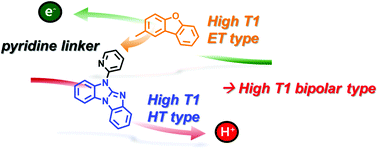Two bipolar host materials were designed and synthesized for blue thermally activated delayed fluorescence (TADF) OLEDs. Both bipolar materials, 5-(4-(dibenzo[b,d]furan-2-yl)-pyridin-2-yl)-5H-benzo[d]benzo-[4,5]imidazo[1,2-a]imidazole (4-DBFBI) and 5-(5-(dibenzo[b,d]furan-2-yl)-pyridin-2-yl)-5H-benzo[d]benzo-[4,5]imidazo[1,2-a]imidazole (5-DBFBI), were constructed with a hole-transporting type of benzimidazole moiety and an electron-transporting type of dibenzofuran moiety, and these derivatives exhibit high triplet energy over 3.10 eV. To achieve a high triplet energy level, a pyridine linker was placed between the benzimidazole and dibenzofuran moieties. As a result, 4-DBFBI and 5-DBFBI showed a high triplet energy level of 3.06 eV and 2.96 eV, respectively. Further, blue TADF devices were fabricated with our synthesized bipolar host materials. For our current study, we adopted 5,10-diphenyl-15-(10-(2,4,6-triisopropylphenyl)-10H-dibenzo[b,e][1,4]oxaborinin-3-yl)-10,15-dihydro-5H-diindolo[3,2-a:3′,2′-c]carbazole (PXB-DI) as the blue TADF dopant. The maximum external quantum efficiencies of the 20 wt% blue TADF devices were 31.8 and 32.5% for 4-DBFBI and 5-DBFBI, respectively. Moreover, the 4-DBFBI based host device exhibited a very low efficiency roll-off of 0.93 up to 1000 cd m−2, which is attributed to its well-balanced charge transporting ability.

